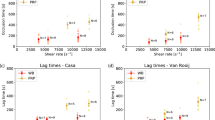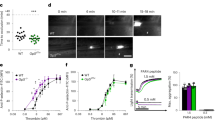Abstract
Platelet aggregation at sites of vascular injury is essential for hemostasis and arterial thrombosis. It has long been assumed that platelet aggregation and thrombus growth are initiated by soluble agonists generated at sites of vascular injury. By using high-resolution intravital imaging techniques and hydrodynamic analyses, we show that platelet aggregation is primarily driven by changes in blood flow parameters (rheology), with soluble agonists having a secondary role, stabilizing formed aggregates. We find that in response to vascular injury, thrombi initially develop through the progressive stabilization of discoid platelet aggregates. Analysis of blood flow dynamics revealed that discoid platelets preferentially adhere in low-shear zones at the downstream face of forming thrombi, with stabilization of aggregates dependent on the dynamic restructuring of membrane tethers. These findings provide insight into the prothrombotic effects of disturbed blood flow parameters and suggest a fundamental reinterpretation of the mechanisms driving platelet aggregation and thrombus growth.
This is a preview of subscription content, access via your institution
Access options
Subscribe to this journal
Receive 12 print issues and online access
$209.00 per year
only $17.42 per issue
Buy this article
- Purchase on Springer Link
- Instant access to full article PDF
Prices may be subject to local taxes which are calculated during checkout






Similar content being viewed by others
References
Trip, M.D., Cats, V.M., van Capelle, F.J. & Vreeken, J. Platelet hyperreactivity and prognosis in survivors of myocardial infarction. N. Engl. J. Med. 322, 1549–1554 (1990).
Ruggeri, Z.M. Platelets in atherothrombosis. Nat. Med. 8, 1227–1234 (2002).
Bhatt, D.L. & Topol, E.J. Scientific and therapeutic advances in antiplatelet therapy. Nat. Rev. Drug Discov. 2, 15–28 (2003).
Virchow, R. Gesammelte abhandlungen zur wissenschaftlichen medicin. Medsinger Sohn & Co. 219–732 (1856).
Savage, B., Saldivar, E. & Ruggeri, Z.M. Initiation of platelet adhesion by arrest onto fibrinogen or translocation on von Willebrand factor. Cell 84, 289–297 (1996).
Savage, B., Almus-Jacobs, F. & Ruggeri, Z.M. Specific synergy of multiple substrate-receptor interactions in platelet thrombus formation under flow. Cell 94, 657–666 (1998).
Nesbitt, W.S. et al. Distinct glycoprotein Ib/V/IX and integrin αIIbβ3-dependent calcium signals cooperatively regulate platelet adhesion under flow. J. Biol. Chem. 277, 2965–2972 (2002).
Nesbitt, W.S. et al. Intercellular calcium communication regulates platelet aggregation and thrombus growth. J. Cell Biol. 160, 1151–1161 (2003).
Giuliano, S., Nesbitt, W.S., Rooney, M. & Jackson, S.P. Bidirectional integrin αIIbβ3 signalling regulating platelet adhesion under flow: contribution of protein kinase C. Biochem. J. 372, 163–172 (2003).
Goncalves, I., Nesbitt, W.S., Yuan, Y. & Jackson, S.P. Importance of temporal flow gradients and integrin αIIbβ3 mechanotransduction for shear activation of platelets. J. Biol. Chem. 280, 15430–15437 (2005).
Ruggeri, Z.M. & Mendolicchio, G.L. Adhesion mechanisms in platelet function. Circ. Res. 100, 1673–1685 (2007).
Ruggeri, Z.M. The role of von Willebrand factor in thrombus formation. Thromb. Res. 120 Suppl 1, S5–S9 (2007).
Jackson, S.P. The growing complexity of platelet aggregation. Blood 109, 5087–5095 (2007).
Dubois, C., Panicot-Dubois, L., Gainor, J.F., Furie, B.C. & Furie, B. Thrombin-initiated platelet activation in vivo is vWF independent during thrombus formation in a laser injury model. J. Clin. Invest. 117, 953–960 (2007).
van Gestel, M.A. et al. Real-time detection of activation patterns in individual platelets during thromboembolism in vivo: differences between thrombus growth and embolus formation. J. Vasc. Res. 39, 534–543 (2002).
Maxwell, M.J. et al. Identification of a 2-stage platelet aggregation process mediating shear-dependent thrombus formation. Blood 109, 566–576 (2007).
Furie, B. & Furie, B.C. Thrombus formation in vivo. J. Clin. Invest. 115, 3355–3362 (2005).
Ruggeri, Z.M., Orje, J.N., Habermann, R., Federici, A.B. & Reininger, A.J. Activation-independent platelet adhesion and aggregation under elevated shear stress. Blood 108, 1903–1910 (2006).
Mustard, J.F., Jorgensen, L., Hovig, T., Glynn, M.F. & Rowsell, H.C. Role of platelets in thrombosis. Thromb. Diath. Haemorrh. Suppl. 21, 131–158 (1966).
Mustard, J.F., Murphy, E.A., Rowsell, H.C. & Downie, H.G. Factors influencing thrombus formation in vivo. Am. J. Med. 33, 621–647 (1962).
Dopheide, S.M., Maxwell, M.J. & Jackson, S.P. Shear-dependent tether formation during platelet translocation on von Willebrand factor. Blood 99, 159–167 (2002).
Antithrombotic Trialists' Collaboration. Collaborative meta-analysis of randomised trials of antiplatelet therapy for prevention of death, myocardial infarction and stroke in high risk patients. Br. Med. J. 324, 71–86 (2002).
Dintenfass, L. Rheologic approach to thrombosis and atherosclerosis. Angiology 15, 333–343 (1964).
Stein, P.D. & Sabbah, H.N. Measured turbulence and its effect on thrombus formation. Circ. Res. 35, 608–614 (1974).
Yoganathan, A.P., Corcoran, W.H., Harrison, E.C. & Carl, J.R. The Bjork-Shiley aortic prosthesis: flow characteristics, thrombus formation and tissue overgrowth. Circulation 58, 70–76 (1978).
Schoephoerster, R.T., Oynes, F., Nunez, G., Kapadvanjwala, M. & Dewanjee, M.K. Effects of local geometry and fluid dynamics on regional platelet deposition on artificial surfaces. Arterioscler. Thromb. 13, 1806–1813 (1993).
Eckstein, E.C., Tilles, A.W. & Millero, F.J. III. Conditions for the occurrence of large near-wall excesses of small particles during blood flow. Microvasc. Res. 36, 31–39 (1988).
Wang, S.K. & Hwang, N.H. On transport of suspended particulates in tube flow. Biorheology 29, 353–377 (1992).
Kulkarni, S. et al. A revised model of platelet aggregation. J. Clin. Invest. 105, 783–791 (2000).
Schoenwaelder, S.M. et al. Identification of a unique co-operative phosphoinositide 3-kinase signaling mechanism regulating integrin α3 adhesive function in platelets. J. Biol. Chem. 282, 28648–28658 (2007).
Denis, C. et al. A mouse model of severe von Willebrand disease: defects in hemostasis and thrombosis. Proc. Natl. Acad. Sci. USA 95, 9524–9529 (1998).
Kulkarni, S. et al. Techniques to examine platelet adhesive interactions under flow. Methods Mol. Biol. 272, 165–186 (2004).
Léon, C. et al. Defective platelet aggregation and increased resistance to thrombosis in purinergic P2Y(1) receptor-null mice. J. Clin. Invest. 104, 1731–1737 (1999).
Mayadas, T.N., Johnson, R.C., Rayburn, H., Hynes, R.O. & Wagner, D.D. Leukocyte rolling and extravasation are severely compromised in P selectin-deficient mice. Cell 74, 541–554 (1993).
Rosen, E.D. et al. Laser-induced noninvasive vascular injury models in mice generate platelet- and coagulation-dependent thrombi. Am. J. Pathol. 158, 1613–1622 (2001).
Kurz, K.D., Main, B.W. & Sandusky, G.E. Rat model of arterial thrombosis induced by ferric chloride. Thromb. Res. 60, 269–280 (1990).
Sturgeon, S.A., Jones, C., Angus, J.A. & Wright, C.E. Advantages of a selective β-isoform phosphoinositide 3-kinase antagonist, an anti-thrombotic agent devoid of other cardiovascular actions in the rat. Eur. J. Pharmacol. 587, 209–215 (2008).
Mangin, P. et al. Thrombin overcomes the thrombosis defect associated with platelet GPVI/FcRgamma deficiency. Blood 107, 4346–4353 (2006).
Weibel, D.B., Diluzio, W.R. & Whitesides, G.M. Microfabrication meets microbiology. Nat. Rev. Microbiol. 5, 209–218 (2007).
Fouras, A., Lo Jacono, D. & Hourigan, K. Target-free stereo PIV: a novel technique with inherent error estimation and improved accuracy. Exp. Fluids 44, 317–329 (2008).
Fouras, A.S.J. Accuaracy of out-of-plane vorticity measurements derived from in-plane velocity field data. Exp. Fluids 25, 409–430 (1998).
Edmondson, K.E., Denney, W.S. & Diamond, S.L. Neutrophil-bead collision assay: pharmacologically induced changes in membrane mechanics regulate the PSGL-1/P-selectin adhesion lifetime. Biophys. J. 89, 3603–3614 (2005).
Yap, C.L. et al. Synergistic adhesive interactions and signaling mechanisms operating between platelet glycoprotein Ib/IX and integrin alpha IIbbeta 3. Studies in human platelets and transfected Chinese hamster ovary cells. J. Biol. Chem. 275, 41377–41388 (2000).
Versteeg, H. & Malalasekrera, W. An Introduction to Computational Fluid Dynamics: The Finite Volume Method (Longman Scientific & Technical, Harlow, UK, 1995).
Acknowledgements
We thank Z. Ruggeri, H.H. Salem, R. Andrews and B. Kile for helpful feedback on the work; H. Blackburn and G. Rosengarten for advice and input on the CFD analysis; C. Nguyen for technical assistance in the analysis of in vivo blood flow rates; SciTech Proprietary Ltd. and Andor Proprietary Ltd. for the generous loan of a DV897CS EMCCD camera; M. Hickey (Monash University Department of Medicine, Monash, Australia) and A. Issekutz (Dalhousie University, Halifax, Canada) for providing the P-selectin–specific antibody; and C. Gachet (INSERM, Strasbourg, France) for P2Y1−/− mice. This work was supported by project funding from the National Health and Medical Research Council of Australia and the Australian Research Council. E.W. was supported by the National Heart Foundation of Australia.
Author information
Authors and Affiliations
Contributions
W.S.N. designed the study and experiments, performed the in vitro platelet and micro-PIV experiments, codesigned vascular mimetics, performed microchannel perfusion experiments, analyzed data, supervised the study and cowrote the manuscript. E.W. designed experiments, performed the in vivo and in vitro experiments, analyzed data and assisted with manuscript preparation. F.J.T.-L. codesigned and fabricated vascular mimetics (microchannels), performed microchannel perfusion experiments and performed CFD simulations. E.T. performed and analyzed the micro-PIV experiments. J.F. performed in vivo experiments. A.M. codesigned the vascular mimetics and supervised their fabrication. J.C. supervised the micro-PIV analysis. A.F. designed and supervised the micro-PIV analysis and formulated and coded the micro-PIV analysis software. S.P.J. supervised the study and cowrote the manuscript.
Corresponding authors
Supplementary information
Supplementary Text and Figures
Supplementary Figs. 1–6 and Supplementary Methods (PDF 975 kb)
Supplementary Video 1
Rheology-driven platelet aggregation in vivo. (MOV 2808 kb)
Supplementary Video 2
Shear microgradient-induced platelet aggregation in vitro. (MOV 2976 kb)
Supplementary Video 3
Discoid aggregate formation independent of ADP, TXA2 and thrombin. (MOV 3197 kb)
Supplementary Video 4
Discoid platelet aggregation and aggregate consolidation in vivo. (MOV 3433 kb)
Supplementary Video 5
Platelet tethering interactions in vivo and in vitro. (MOV 2814 kb)
Supplementary Video 6
Intracellular calcium flux during platelet tether restructuring. (MOV 3110 kb)
Rights and permissions
About this article
Cite this article
Nesbitt, W., Westein, E., Tovar-Lopez, F. et al. A shear gradient–dependent platelet aggregation mechanism drives thrombus formation. Nat Med 15, 665–673 (2009). https://doi.org/10.1038/nm.1955
Received:
Accepted:
Published:
Issue Date:
DOI: https://doi.org/10.1038/nm.1955
This article is cited by
-
Investigating clot-flow interactions by integrating intravital imaging with in silico modeling for analysis of flow, transport, and hemodynamic forces
Scientific Reports (2024)
-
Shear Histories Alter Local Shear Effects on Thrombus Nucleation and Growth
Annals of Biomedical Engineering (2024)
-
Microfluidic thrombosis analysis system: possibilities and limitations
Micro and Nano Systems Letters (2023)
-
Analysis of Thrombosis Formation and Growth Using Microfluidic Chips and Multiphase Computational Fluid Dynamics
BioChip Journal (2023)
-
Maximizing flow rate in single paper layer, rapid flow microfluidic paper-based analytical devices
Microfluidics and Nanofluidics (2023)



